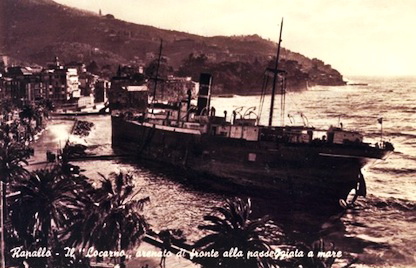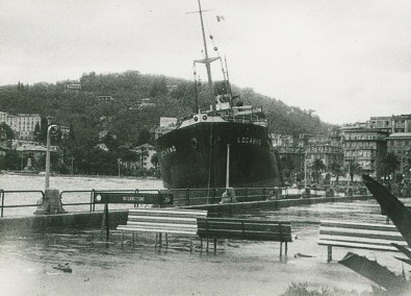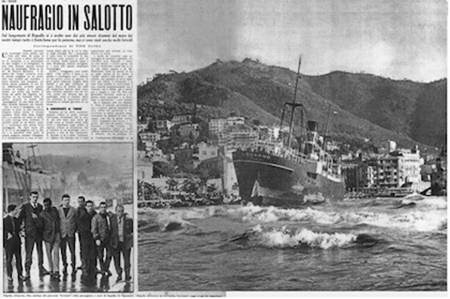LOCARNO

This steam cargo vessel DUNSLEY was built at Robert Thompson Shipyard, Southwick, Sunderland, England (on the River Wear on the East Coast). Launched on 20.03.1928. With hull number 336, she was one of the last ships built in this shipyard before its closure in 1930 (Yard/hull No. 341). In September 1929 she was delivered to her owners Headlam & Son's Steamship Co. Ltd. of Whitby, North Yorkshire, England. She sailed under British flag and her home port was Whitby (Official No.: 1161013 / Call sign GJYN). Her trading area was the North Atlantic, mainly between the United Kingdom and Canada.
On 02.12.1940 the DUNSLEY was underway from Canada to the United Kingdom, straggling behind her convoy, when she was attacked with gun fire by the German submarine U-47 (Günther Prien), west of Northern Ireland. Her cargo consisted of steel and timber. Apparently the timber deck cargo caught fire, but the fire was extinguished by her crew. The ship's hull and cargo gear was damaged (see uboat.net).
In early 1945, sailing in a convoy in the North Atlantic she suffered a collision with the Ellerman Liner CITY OF GLASGOW, but no further details are available.
On 20.01.1946 the DUNSLEY was en route from Leith, Scotland to the Tees, when she ran aground in dense fog on East Scar, a rocky ledge off Redcar, near the mouth of the Tees. She was driven stern first onto Stokesley Scar with her bows in the sand. The local lifeboat offered assistance, but the crew twice refused to be evacuated. The vessel was later refloated with the help of tugs and repaired.
In 1954 the freighter was purchased by Sebastiano Tuillier of Lugano, Switzerland and renamed LOCARNO (Registered owner: Compañia de Navegación Costaricense "San Juan" Ltda., Puerto Limón) and registered under the flag of Costa Rica. Call sign: TIFD.
About a month later, the LOCARNO loaded ore in Aguilas, Spain and on departure she drifted ashore and grounded. She was refloated and repaired in Gibraltar. After repair transferred to Compañia de Navegación San Rocco S.A., Puerto Limón.
1959: Changed flag to Panama. Call sign: HPXI.
On 03.01.1961 the vessel was en route from Genoa to Follonica (Portiglione), Italy, when she ran aground at Rapallo, near Genoa. The vessel was refloated and towed to La Spezia, Italy and declared a total constructive loss. Subsequently she was demolished by Cantieri Navali del Golfo in La Spezia, Italy (see story below).
SwissShips, HPS, MB, August 2014
Additional Informationen and Stories
Stranding on the promenade of Rapallo, Italy, January 1961
Sailing from Lübeck in West Germany, the LOCARNO arrived on 20.12.1960 in Genoa (at Ponte Rubattino) to discharge a cargo of 6000 tonnes of steel slabs. The discharge of the cargo took its time and therefore the crew passed a peaceful and tranquil Christmas and New Year in port.
In the morning of 03.01.1961 the ship was ready to sail, the next destination was Follonica (Portiglione) in the Toskana, only about 118 miles away to the East, to pick up a cargo of minerals for Germany. The vessel was in ballast, fore- and aft peak, all double bottom tanks were full of sea water. The draft was probably around 3,0 to 3,5 meters only. The crew on board was 23 men, including the master. Many of the crew were from Genoa, one man was from Abyssinia (today Ethiopia). The master was from Torre del Greco, near Naples.
After having received the clearance from the Capitaneria (harbour master), the captain called the pilot for sailing at 08:00 hours. When the pilot arrived alongside the vessel, he observed, that the gangway was taken up and secured and the pilot ladder was already in place on the ship's sea side. For the workers in port, it meant the captain was in a hurry to sail…
After the pilot arrived on the bridge, he told the master "Captain, a strong south westerly storm of about force 6/7 is coming up, I strongly recommend to postpone your departure for some hours. Your vessel is empty "a pallone" (like a balloon) and there is no improvement at least for the next 12 hours". But Captain Vittorio Sallustro determined to sail, replied "The trip is only short, about 10 to 12 hours to arrive at Follonica. This ship resisted all the storms since we left Lübeck, first in the Skagerrak, then in the North Sea, in the English Channel, in the Golf of Biscay and in the Golf of Lions. Mister Pilot, be quiet. We will see, if there are any problems we come back and give you a call".
A collegue of mine, pilot L.A. who took her out, told me years later, the vessel was rolling so heavily, that the tips of the life boat davits almost touched the crests of the waves.
Shortly before 10:00 hours the LOCARNO passed the lighthouse of Portofino, when the captain realised, that it was too dangerous to continue the voyage and decided to take shelter in the Gulf of Tigullio. Little later the ship was off Punta Pedale at Santa Margherita and dropped her anchor. The captain at this point was hoping that the wind would turn into a northerly direction and he could continue his voyage.
Unfortunately the wind turned into a south easterly direction (the "Scirocco") and the captain decided to heave anchor and head for the open sea, preparing himself for an ugly night at sea. Once the anchor was up, he gave "full ahead" to the engine room, to get the stern away from the rocks and gain the open sea. However the LOCARNO being in ballast with high ship's sides exposed to the wind, the engine power was insufficient to gain any head way. Despite numerous attempts "full ahead" and "full astern", the freighter eventually was pushed athwart the wind. The ship was pushed by the strong winds and drifted irresistibly towards the inner end of the gulf of Tigullio with the touristic town of Rapallo.
Apparently at about this time, the captain asked for tug assistance from Genoa, of course his demand was rather late, if not already too late. The tugs had about two hours, running against a current of about 0,5 knots during normal weather conditions, but with a full south easterly storm this took more time, especially as the current under these conditions could run as high as 5,0 knots. Further, at the time, the tug boats of Genoa were all old steam tugs of about 600 to 800 HP with a large hull and a draft of about 5,0 to 6,0 meters. To enter the Bay under the prevailing sea and weather conditions was too dangerous.

The LOCARNO, note the broken-off rudder
To stop the vessel from further drifting, the master ordered to drop both anchors. The vessel showed now with the bow towards the sea. "The anchors are holding". With engine manoeuvres it was tried to alleviate the forces on the anchors, but this respite lasted only for about one hour, then the strength of the storm increased again and the anchors commenced to drag on the sandy seabed of the bay. The situation of the vessel could be maintained until about midnight. The lights of the town and of the promenade were clearly visible.
But all has its limits, the starboard anchor chain broke with a loud bang. The only measure now possible was to manoeuvre with the engine to try to avoid the rocks and other obstacles, like the promenade and the old fort, protruding from the shore line. Another danger crept up, if the hull touched one of the shallow banks, the ship could capsize.
In any case, the LOCARNO drifted through all the banks, avoided the rocks and settled in front of Rapallo's sea promenade, just at the most spectacular place, in front of the hotel Excelsior, like a big whale, this probably happened in the early hours of 04.01.1961. At about 04:00 the crew could rig a gangway to the shore. The crew were served a hot meal on the shore side.

The LOCARNO at the promenade, note the starboard anchor and chain were lost
At 19:20 a messenger line with a plastic bag was passed to the ship, asking the state of the crew. Captain responded same way no injured on board. Because of the hauling winds and crashing waves it was not possible to communicate by voice or megaphone. The klaxon of a car, positioned close to the vessel, was used to give morse signals.
Not much later, all the souvenir shops of Rapallo offered post cards in many variations of the stricken steamer.
The LOCARNO remained for 43 days in Rapallo until she was refloated on 15.02.1961 and then was towed by a tug of Società Rimorchiatori Riuniti, Genoa to La Spezia for demolition. The demolition is believed, took place in one of the yards of Neri Group.

Newspaper article "Naufragio in Salotto" or "Shipwrecked in the living room"
The Italian weekly newspaper "Oggi" ran an article on the event in Rappallo and titled it "Shipwrecked in the Living Room". Below is a free translation of the content:
The article "Shipwrecked in the living room"
One of the most unusual dramas of our time took place on the Rappallo waterfront. For the people involved, everything went smoothly, yet there was also a lot of gruesomeness. A shipwreck like this had never been seen before, usually ships sink in the middle of the ocean in stormy seas, they break up on a reef or they run aground on a deserted roadstead. This one, however, was a home-made shipwreck. If Vittorio Sallustro, the captain of the LOCARNO, had been able to find a place in a manual to ground the ship in order to minimise the damage, he could hardly have found a more suitable place than the Gulf of Tigullio. He forced his way through the narrowest part of the gulf and then grounded the ship on a sandbank, right in front of the promenade of one of the world's most famous beach resorts. Now the ship sits aground, with flooded bilges, holds and engine room, the propeller bent and the rudder blade in two. Fuel leaks into the sea and spreads. The whole ship rises out of the water and lies on its side at 15°, ready to capsize in the next storm surge. But 10 m further on is the shore promenade with palm trees and benches where elderly people let the sun warm their bones. 30 m further on are the hotels. For the shipwrecked, all amenities are ready; if the gangway just reaches a small pier, they only need to walk a few steps and they are already in the inn with cosy rooms where chicken on the spit awaits the crew. The holidaymakers are also satisfied. How nice that the captain has just been stranded here, they said to themselves the last few days. The women, mostly from Milan, who have fled the Lombardy cold and fog, sit behind the windows of the cafés on the promenade, which is lapped by the waves. They have watched the various phases of the stranding with a slight shudder, like in the cinema, happy that something unexpected has enriched their holiday.
SwissShips, HPS, 07.08.2014 / December 2022